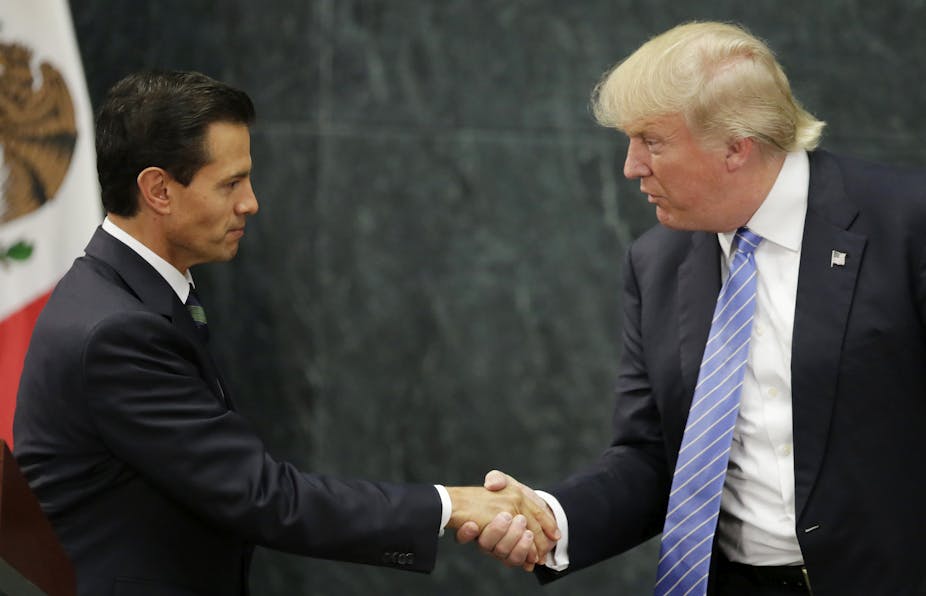Editor’s note: The following is a roundup of archival stories related to immigration and the presidential campaign.
Donald Trump took a last-minute trip to Mexico on Wednesday. He met with President Enrique Peña Nieto before appearing at a rally in Arizona, in which he sought to clarify his positions on immigration.
Those who were hoping to hear him soften his tone in an attempt to expand his base were disappointed. Trump talked tough:
“We will break the cycle of amnesty and illegal immigration. We will break the cycle. There will be no amnesty. Our message to the world will be this: You cannot obtain legal status or become a citizen of the United States by illegally entering our country.”
But, do his ideas about immigration make sense in light of what experts say? Here are highlights of The Conversation’s coverage of immigration issues.
The wall, the ban
If elected, Trump said he will build a wall between the U.S. and Mexico, and make Mexico pay for it. But a wall may not be necessary, according to migration data. David Cook Martín, a professor of sociology at Grinnell College, writes that thousands of Mexicans are leaving the U.S. of their own accord and returning to Mexico for a variety of reasons.
“The study shows a net loss of 140,000 Mexican immigrants from the United States. One million Mexican migrants and their children left the U.S. for Mexico, while just over 860,000 left Mexico for the United States.”
Of course, Mexicans are certainly not the only people crossing the U.S. border. Caitlin Fouratt, a professor of international studies at California State University, Long Beach writes about the thousands of Central Americans fleeing violence in Guatemala, Honduras and El Salvador – a region known as the Northern Triangle.
“In the first six months of the current fiscal year, the U.S. border patrol apprehended 120,700 people from the Northern Triangle countries attempting to enter the U.S. Some of those who cross the border will apply for asylum, but the majority will be sent back to their countries of origin and the violence they were fleeing.”
Trump has also previously called for a ban on Muslim immigrants. Scholars deemed this position un-American, as Sahar Aziz, professor of law at Texas A&M University writes:
“At a time when most Americans are taught that our nation is post-racial and that we have moved beyond Japanese internment or Chinese exclusion laws, Trump’s statements and consequent rise in the polls remind us that our nation has not advanced as much as we’d like to believe.”
The 11 million here
Another major focus of U.S. immigration debate has been finding a solution for the estimated 11 million immigrants who already live in the U.S. without a visa or a pathway to citizenship.
Trump criticized President Obama’s use of executive action to create a program to shield immigrants brought to the U.S. as children from deportation. Obama also created a similar program for parents of children who are U.S. citizens in 2014 – Deferred Action for Parents of Americans.
In U.S. vs. Texas, 26 states refused to enforce the program and challenged Obama’s use of executive action. The case went to the Supreme Court, and in June, the Court reached a 4-4 deadlock decision. Shana Tabak, professor of law at Georgia State University writes:
“Now, the millions who would have been eligible remain stranded, fearful of deportation and unable to legally work… This executive action represented an opportunity for many to finally come out of the shadows. President Obama’s previous executive action, DACA, has dramatically improved the lives of many who were brought to the U.S. as children, allowing them to attend college, work, hold driver’s licenses – to contribute to the societies of which they are a part.”
Trump’s plan also highlighted enforcing deportation of undocumented immigrants by tripling the number of Immigration and Customs Enforcement agents and creating a special deportation taskforce. What would be the effect of such a policy?
Miliann Kang, professor of Women, Gender and Sexuality Studies at the University of Massachusetts Amherst points out that mass deportation has and would have continued negative effects on millions of children who are born in the U.S. and are legal U.S. citizens.
“Sammy is a teenager I recently met who was born and raised in the Southwest. His parents were living in the U.S., working and raising their children, until they were stopped for a traffic violation, or audited for taxes, or turned in by a teacher or medical provider, or any of the mundane ways that undocumented status gets uncovered. Now Sammy is living with foster parents.”

